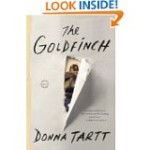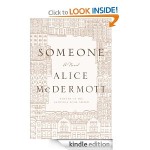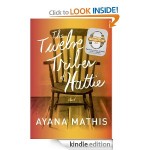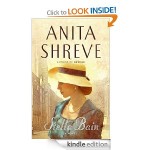Here are some recommended titles from my recent reading list. As always, it’s a mixed bag of literary novels and more plot-driven stories.
Claire of the Sea Light, by Edwidge Danticat
 Of all the books I’ve read recently, this is hands down my favorite of this batch. The writing is luminous, textured, and rich. Though much of the book is dark and tragic, light is woven through it in beautiful and surprising ways that provide ballast to the heavy undercurrents. The Claire of the title is a young girl being raised by her widowed fisherman father; theirs is one of several intermingled stories featuring various characters whose lives hang in the balance between despair and hope. Based in Danticat’s native Haiti, this is a tale in which poverty and violence live side by side with tenderness, splendor, and love.
Of all the books I’ve read recently, this is hands down my favorite of this batch. The writing is luminous, textured, and rich. Though much of the book is dark and tragic, light is woven through it in beautiful and surprising ways that provide ballast to the heavy undercurrents. The Claire of the title is a young girl being raised by her widowed fisherman father; theirs is one of several intermingled stories featuring various characters whose lives hang in the balance between despair and hope. Based in Danticat’s native Haiti, this is a tale in which poverty and violence live side by side with tenderness, splendor, and love.
The Goldfinch by Donna Tartt
 Where to even begin with this ambitious, enormous wild ride of a book? It’s big, it’s bold, and it’s a great read – no question of that and it’s easy to understand why it was shortlisted for the National Book Award. I’ve heard it described at Catcher in the Rye for the 21st century, which sort of works, and as a post 9/11 novel, which also makes sense. But it’s much more than either of those descriptions. It’s a coming-of-age story under unusual circumstances in an unfair and uncertain world, a trip through adolescence and the long road out into adulthood on the part of a character who’s had more than his fair share of trials and tribulations. The characters are wonderfully drawn, quirky and compellingly real, as is the plot. There’s heartache and love, drugs and kindness, cruelty and fear, generosity and violence. This book has it all in abundance. Not everything in the plot is completely plausible, but on the other hand much of it is extremely believable, familiar, and masterfully narrated. Whatever its flaws, when this novel ended it was hard to say goodbye to those who peopled its pages.
Where to even begin with this ambitious, enormous wild ride of a book? It’s big, it’s bold, and it’s a great read – no question of that and it’s easy to understand why it was shortlisted for the National Book Award. I’ve heard it described at Catcher in the Rye for the 21st century, which sort of works, and as a post 9/11 novel, which also makes sense. But it’s much more than either of those descriptions. It’s a coming-of-age story under unusual circumstances in an unfair and uncertain world, a trip through adolescence and the long road out into adulthood on the part of a character who’s had more than his fair share of trials and tribulations. The characters are wonderfully drawn, quirky and compellingly real, as is the plot. There’s heartache and love, drugs and kindness, cruelty and fear, generosity and violence. This book has it all in abundance. Not everything in the plot is completely plausible, but on the other hand much of it is extremely believable, familiar, and masterfully narrated. Whatever its flaws, when this novel ended it was hard to say goodbye to those who peopled its pages.
Someone by Alice McDermott
 This spare and elliptical novel is the winner of the National Book Award. The main character is an Irish-American woman growing up in Brooklyn. The segments of narration about this ordinary life go back and forth in time, from early childhood to old age and back again, looping in and out. The writing is compelling but never soft or sentimental. The very averageness of the life described within is what is extraordinary about this book – there are no surprises, no secrets, no out-of-character acts, just the stark elegance of a life lived through one breath to another, through one relationship to another, through one time to another. Some moments in particular stand out in their unadorned clarity as the character grows and develops and circles back in time. Despite the seeming ordinariness of the tale, McDermott makes her character someone indeed, and makes us care about her.
This spare and elliptical novel is the winner of the National Book Award. The main character is an Irish-American woman growing up in Brooklyn. The segments of narration about this ordinary life go back and forth in time, from early childhood to old age and back again, looping in and out. The writing is compelling but never soft or sentimental. The very averageness of the life described within is what is extraordinary about this book – there are no surprises, no secrets, no out-of-character acts, just the stark elegance of a life lived through one breath to another, through one relationship to another, through one time to another. Some moments in particular stand out in their unadorned clarity as the character grows and develops and circles back in time. Despite the seeming ordinariness of the tale, McDermott makes her character someone indeed, and makes us care about her.
The Position by Meg Wolitzer
 This isn’t Wolitzer’s newest novel, but it sounded promising. At the center is the wonderfully and ironically named Mellow. The Mellow parents are the authors of the famous (or infamous, depending on your perspective) ground-breaking book Pleasuring: One Couple’s Journey, sort of a fictionalized version of The Joy of Sex, which was explored one fateful afternoon in the 70’s by their four children. The plot revolves around the impact of this book on the family of six, and the ways in which the ripple effects shaped the life of all of them in different ways during the next decades. There are many questions here about what it is to be a parent, how much parents can and should pursue their personal (and physical) passions and at what cost to their children, and how much children’s sense of self is based on what they see modeled by their parents? Like many of Wolitzer’s novels, the writing veers between empathetic and pitiless. She looks honestly at her characters and their flaws, while caring for them deeply and making us care about them.
This isn’t Wolitzer’s newest novel, but it sounded promising. At the center is the wonderfully and ironically named Mellow. The Mellow parents are the authors of the famous (or infamous, depending on your perspective) ground-breaking book Pleasuring: One Couple’s Journey, sort of a fictionalized version of The Joy of Sex, which was explored one fateful afternoon in the 70’s by their four children. The plot revolves around the impact of this book on the family of six, and the ways in which the ripple effects shaped the life of all of them in different ways during the next decades. There are many questions here about what it is to be a parent, how much parents can and should pursue their personal (and physical) passions and at what cost to their children, and how much children’s sense of self is based on what they see modeled by their parents? Like many of Wolitzer’s novels, the writing veers between empathetic and pitiless. She looks honestly at her characters and their flaws, while caring for them deeply and making us care about them.
The Twelve Tribes of Hattie by Ayana Mathis
 This absorbing tale portrays the struggle of a family over time, centered around the main character of Hattie, the mother of this large clan. Each section tells of a different family member, spanning from the early 1920’s to 1980. Hattie is a product of the Great Migration that brought Southern blacks to the North in the quest for a better life. The various members of her family are beautifully brought to life as complex and nuanced individuals as they struggle with heartbreak, disappointment, and the search for an authentic self.
This absorbing tale portrays the struggle of a family over time, centered around the main character of Hattie, the mother of this large clan. Each section tells of a different family member, spanning from the early 1920’s to 1980. Hattie is a product of the Great Migration that brought Southern blacks to the North in the quest for a better life. The various members of her family are beautifully brought to life as complex and nuanced individuals as they struggle with heartbreak, disappointment, and the search for an authentic self.
Stella Bain by Anita Shreve
 If you want something fast and engaging that doesn’t ask too much of you as a reader, this is a great choice. Shreve is a great story-teller, able to create intriguing situations and characters we want to know better. This plot-driven book is about a woman who loses her memory on the battlefield during World War I, and her search for both her memory and what is hers. Slowly she becomes empowered and a happy ending is in sight, with all the loose ends nicely tied up.
If you want something fast and engaging that doesn’t ask too much of you as a reader, this is a great choice. Shreve is a great story-teller, able to create intriguing situations and characters we want to know better. This plot-driven book is about a woman who loses her memory on the battlefield during World War I, and her search for both her memory and what is hers. Slowly she becomes empowered and a happy ending is in sight, with all the loose ends nicely tied up.
The Last Runaway by Tracy Chevalier
 This book of historical fiction is another quick but satisfying read. The main character is a young Quaker Englishwoman who comes to Ohio at her sister’s side. Things turn out far from expected, and her Quaker beliefs are put to many tests, in particular regarding slavery and the Underground Railroad. The history of quilting also plays an interesting role in the story.
This book of historical fiction is another quick but satisfying read. The main character is a young Quaker Englishwoman who comes to Ohio at her sister’s side. Things turn out far from expected, and her Quaker beliefs are put to many tests, in particular regarding slavery and the Underground Railroad. The history of quilting also plays an interesting role in the story.







